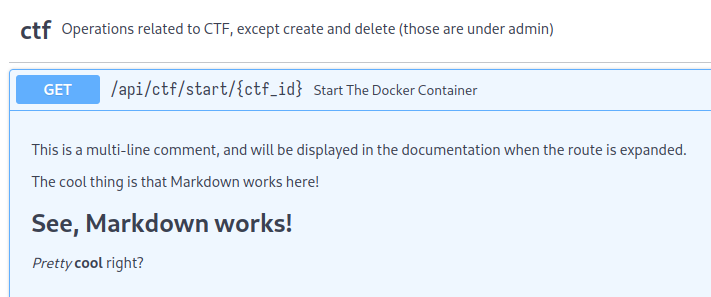A CTF platform backend written in FastAPI using Tortoise-ORM, Tox and Pydantic
- Remove
round2logic and paths - feat: Power ups
- fix: Leaderboard caching error
- Issue identification and Bug fixes
- Setup tests using
tox - feat: Leaderboard graph
Before you begin, ensure you have met the following requirements:
- Python 3.7+
- Docker (optional, for container functionality)
-
Clone the repository (or a fork of the repository):
git clone https://github.com/lugvitc/pwncore.git cd pwncore -
Set up a virtual environment:
python3 -m venv .venv source .venv/bin/activate -
Install Poetry and project dependencies:
pip install poetry poetry install
-
Configure the project:
- Open
src/pwncore/config.py - Set
db_urlto a path for persistent storage or continue with in-memory database - Configure
docker_urlas needed (see Usage for details)
- Open
-
Start:
cd src uvicorn pwncore:app --reload -
Access the auto-generated documentation at http://localhost:8000/docs
-
Docker configuration:
- Enable and start the Docker service on your system, or
- Modify
src/pwncore/config.py:62:
docker_url="http://google.com", # For testing without Docker.
├── Dockerfile
├── LICENSE
├── OVERVIEW.md
├── poetry.lock
├── poetry.toml
├── pyproject.toml
├── README.md
├── src
│ └── pwncore
│ ├── config.py
│ ├── container.py
│ ├── docs.py
│ ├── __init__.py
│ ├── __main__.py
│ ├── models
│ │ ├── container.py
│ │ ├── ctf.py
│ │ ├── __init__.py
│ │ ├── pre_event.py
│ │ ├── round2.py
│ │ └── user.py
│ ├── py.typed
│ ├── routes
│ │ ├── admin.py
│ │ ├── auth.py
│ │ ├── ctf
│ │ │ ├── __init__.py
│ │ │ ├── pre_event.py
│ │ │ └── start.py
│ │ ├── __init__.py
│ │ ├── leaderboard.py
│ │ ├── round2.py
│ │ └── team.py
│ └── types.py
├── tests
│ ├── __init__.py
│ └── test_login.py
└── tox.ini
7 directories, 32 files
FastAPI generates documentation for the routes using OpenAPI. The documentation is available by default at /docs (Swagger UI) and /redoc (ReDoc).
There are 2 ways to add documentation for a route:
- Explicitly mention the summary and description:
@router.get("/start/{ctf_id}",
description="This description supports **Markdown**.",
summary="Start the docker container"
)- Let it infer summary from function name and description from comments:
@router.get("/start/{ctf_id}")
async def start_the_docker_container(ctf_id: int): # The function name is inferred for the summary
# This is a regular single-line comment.
# Will not be displayed in the documentation.
'''
This is a multi-line comment, and will be displayed
in the documentation when the route is expanded.
The cool thing is that Markdown works here!
# See, Markdown works!
_Pretty_ **cool** right?
'''
return {"status": "CTF started"}Result:
Follow the following steps while working on the platform
- Fork the repository
- Create your feature branch (
git checkout -b feature/functionality) - Commit your changes (
git commit -m 'Add some functionality'). Go through CONTRIBUTING for preferred commit messages - Push to the branch (
git push origin feature/functionality) - Open a Pull Request
This project is licensed under the [GNU GENERAL PUBLIC LICENSE] - see the LICENSE file for details.
